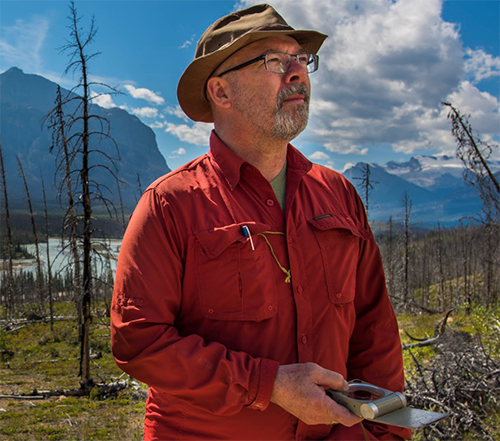Spring 2021

| Speaker: |
Stephen Johnston |
| Title: | Laurentia in the mid-Cretaceous (120 to 90 Ma): Reconciling the Cordilleran and Cratonic geological records |
| Date: | March 19, 2021 |
| Time: | 11:45am |
| Location: | Contact instructor for details. jemezger@alaska.edu |
About:
My research is focused on understanding how Earth’s geography has changed over geological
time, and determining the significance of Earth’s changing geography for the evolution
of the biosphere and atmosphere. I study current and ancient mountain belts, as mountain
systems develop along plate margins and provide a record of the long-term movements
and plate interactions of continents. Outreach is central to my science, for a public
ignorant of the basic workings of the Earth and of the depth of Earth history, will
never be able to imagine or comprehend the substantial challenge that ongoing climate
change presents for humanity.
Abstract:
The mid-Cretaceous (120 to 90 Ma, hereafter mK) period presents us with an economically
and tectonically significant puzzle when it comes to understanding Laurentia's geological
evolution. It was during this time period that the bulk of Canada's oil and gas reserves
were produced and sequestered, including the massive oil sand
deposits of northern Alberta. The mK also saw the deposition of much of the coal-bearing
strata of BC and Alberta; the development of an enormous gold endowment in BC, Yukon
and Alaska, including the Tintina Gold Belt; formation of the massive Cantung and
MacTung tungsten deposits that lie right on the Yukon-NWT border; emplacement of gem-quality
emerald deposits in the eastern Cordillera of Yukon and northern BC; perhaps the development
or at least the remobilization of Mississippi Valley Pb-Zn deposits including the
Pine Point body; and the eruption of a series of diamondiferous kimberlite pipes that
together define a 4000 km long, N-S striking kimberlite corridor that runs down the
very centre of the continent. Is there an underlying process or tectonic setting that
explains the coeval development of this "mK Bonanza" of important economic mineral
and energy deposits? The development of the kimberlite corridor points to E-W extension
and lithospheric thinning of the continent. An overall extensional setting for the
continent is consistent with the mK opening of the N Atlantic and the Canada basin,
all as part of the coeval acceleration of Pangea breakup.
However, explaining the mK Bonanza as a product of continental extension runs contrary
to most (all?) tectonic models. Why? Because of the Cordilleran Orogen. The orogen
is characterized by mK fold & thrust belts including the Brooks Range of Alaska; the
Selwyn- Columbian of Yukon-BC-Alberta; and the Sevier of the conterminous US. mK contraction
is commonly explained as a result of an increase in the relative rate of convergence
between North America and the Panthalassan oceanic slabs inferred to have been subducting
beneath the continent's west margin. In this 'Accretionary' model, mK strata of Laurentia
east of the Rocky Mountains are interpreted as a retro-arc foreland basin developed
in response to compressive loading of the continental lithosphere. An alternative
'Westward Subduction' model may reconcile the Cordilleran record of arc magmatism
and crustal shortening with lithospheric thinning of cratonic Laurentia. In this model
subduction is beneath the east side of the Cordillera, not the west; there is no Panthalassan
subduction zone; and the Cordillera and its thrust belts occupy the upper plate of
a west-dipping subduction zone. Cratonic Laurentia, forming the lower plate, thins
due to slab pull and is characterized by a ‘lower plate’ hydrocarbon bonanza. The
Cordillera, forming the upper plate, is host to typical arc and arc-continent collisional
mineral deposits. A suite of geological, geophysical and geodynamic studies focused
on
mK strata can test if westward subduction of the continent is a viable model that
reconciles shortening and thickening of Cordilleran lithosphere coeval with thinning
of cratonic Laurentia, and explains the mK mineral and energy Bonanza.
Passcode: x7r3*p?X


